hankyoreh
Links to other country sites 다른 나라 사이트 링크
[Special Features Series: April 3 Jeju Uprising,, Part I] April 3 Massacre on the Olle Trail
Survivors of Jeju Uprising recount their heartbreaking tales of loss

This year marks the 70th anniversary of the April 3 Uprising and Massacre in Jeju. A tragedy of contemporary South Korean history, the event had an estimated death toll between 25,000 and over 30,000 – representing 10% of Jeju Island’s population at the time. The Special Act on the Jeju April 3 Incident blandly defines it as “an incident extending from March 1, 1947, through the turbulence that erupted on April 3, 1948, and on to September 21, 1954, in which residents were killed due to armed clashes and suppression tactics.” But it was a tragedy of contemporary South Korean history, and the scars remain to this day.
For close to 50 years, the massacre remained a taboo topic. The late former President Roh Moo-hyun apologized in Oct. 2003 for the excessive measures taken by state authorities to quash the uprising, but subsequent conservative administrations saw numerous attempts by the right to misrepresent the event. For the 70th anniversary of the uprising, the Hankyoreh is reflecting on its contemporary meaning with a five part series. The symbol of April 3 is the camellia, a flower that represents the Jeju residents who fell silently to the cold earth like red petals on that day.Part 1. April 3 Massacreon the Olle Trails
Part 2. The April 3 Exodus
Part 3. Another Cold War
Part 4. The Silence of White Stone
Part 5. Seven Decades Later
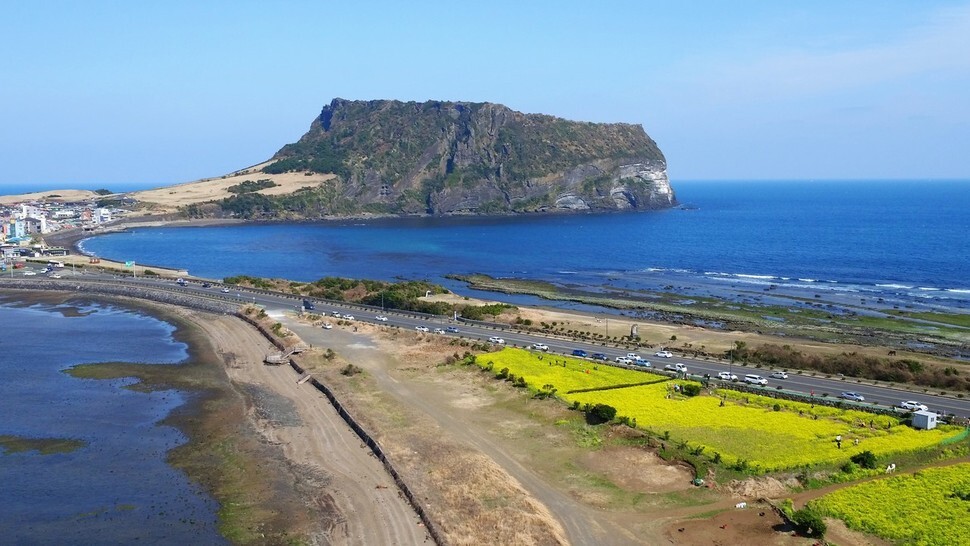
70 years after 10% of the population of Jeju Island was massacred, victims are still awaiting compensation
Those visiting Jeju’s Olle Trail and famous tourist destinations will find the traces of the April 3 Uprising and Massacre covered over with beautiful scenery. On the 17th course at Gwandeokjeong, they will encounter the setting where the incident began. The 1st (Teojinmok), 6th (Jeongbang Falls), and 19th (Hamdeok Beach and Bukchon Village) include sites where massacres were carried out. The 13th (the lost village of Ha-dong at Josu) includes the former site of a vanished village. The 14th (the Jin A-young home) offers a glimpse at personal tragedy, while the 1oth (Hardened Site and Seodal Oreum) shows the scenes of the preventive detention efforts during the Japanese occupation and Korean War. Jeju’s tragic contemporary history remains written on the trails.

A mother’s silver ring discovered 69 years later
“I longed for my mother so badly that I prayed to see her just once, if only in a dream. One night in a dream about 30 years ago, I saw a woman in a beautiful hanbok dress riding the bus. She was there in front of me, and then she started looking at me. Intuitively, I knew it was my mother. The bus was going to Sinyang Village. I got off, and she kept riding.”
In July of last year, Kang Sook-ja found her mother. The 72-year-old, who is a member of the “premier group” of haenyeo (one of Jeju’s diving women) and a resident of Sinyang Village in Jeju’s Seongsan township, was relocating her mother’s remains 69 years after losing her at the age of two. She opened the tomb to see her mother Oh Gye-chun – 36 at the time of her death – exactly as she had been in the dream. Despite the passage of 70 years, the remains were smooth and white, the teeth straight.
On the ring finger of Kang’s left hand on Mar. 4 was a shiny silver ring. “We were relocating my mother’s grave after 69 years, and we found a silver ring,” she said. “Even though 70 years had passed, the ring’s color remained unchanged.”
“I was astonished. I said, ‘Mother, I’ll wear the ring. Thank you.’ I can only imagine how much she must have loved me when I was a two-year-old – that she wanted to give it to me thinking, ‘How can I die like this when I have this child?’ Or maybe she wanted to give it to me as a keepsake because she couldn’t raise me herself.” The silver ring that Kang came across 69 year later is the only possession she inherited from her mother.
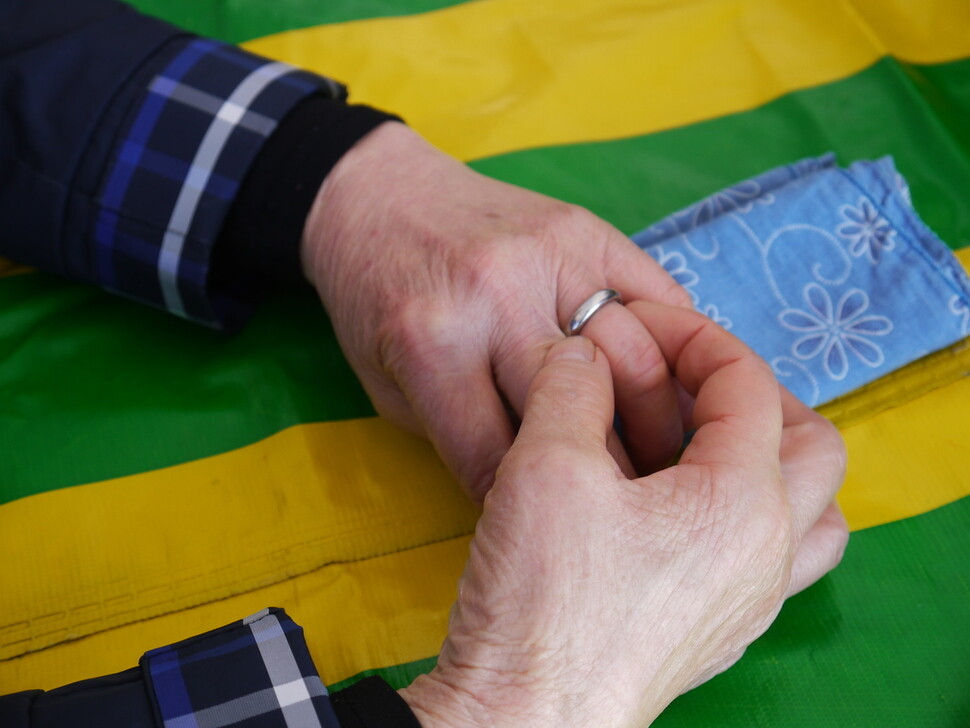
Oh Gye-chun had her beloved daughter Sook-ja when she was 35. On Nov. 27, 1948, when Sook-ja was two years old, Oh was slain at Teojinmok. She had done nothing wrong and thought she would return shortly, leaving her home with then-nursing Sook-ja on her back. Taken to Teojinmok wearing a “serge skirt and serge jacket” with a scarf around her neck, she managed to secure the baby to a passing neighbor with the scarf and articles of clothing, asking that the child be entrusted to her sister’s care. It was their last goodbye. Kang’s then 33-year-old father, Kang Tae-hyeong, had gone missing a few months before Oh lost her life at Teojinmok.
Having lost both her parents, Kang was raised by her mother’s older sister. As she grew up, she learned it was her aunt, but she continued treating her as a mother until her death.
For Kang, the sea is a livelihood. Four years ago, she was persuaded to quit diving by her husband and children, but she remains gifted enough a diver to haul up a 99-kilo turban shell on a day’s dive. She farmed and peddled insurance for a while before returning to the sea. With her duties at night tending to the children and doing chores, she scarcely had enough time in the day. Kang began diving for a living at age 15, working later at Guryongpo in Pohang, North Gyeongsang Province, and on Geoje Island, South Gyeongsang Province, as well as overseas on an island in Japan’s Mie Prefecture to save up money.
Calls for compensating the victims of the Jeju Uprising
“I’d like to go to the National Assembly and tell the politicians, ‘Do you think describing the people who suffered through April 3 as ‘rioters’ freed them to live as they pleased? I think there needs to be compensation. What do you think?’” Kang said.
“I bought a house and a field with the money I saved from diving. I would have starved without the sea. Because of the sea, I’ve been able to eat and raise my children. One of my children is a doctor. I’ve got something to be proud of.” A smile came across Kang’s previously tear-lined face.
On the afternoon of Mar. 10, I stood at Teojinmok, a corner leading to the World Heritage Site of Seongsan Ilchul Peak in Seogwipo City. The spot marks the terminus of the first Jeju Olle trail. The placid sea and blue sky form a picture-perfect scene behind the peak. A line of rental cars sat by the side of the trail. Against the backdrop of the yellow rape blossoms announcing the arrival of Jeju’s spring, tourists with selfie sticks snapped souvenir shots, reveling in the spring day.
Over to one side was a stone marking the “site of the massacre of civilian residents of Seongsan Township on April 3.” Many other residents of the Seongsan area lost their lives here like Kang’s mother. Teojinmok was a routine setting for executions. Considered by South Korean and foreign tourists today as one of Jeju’s most beautiful scenes, it is described by residents as a “place of bitterness and tears.”
While the scorched earth campaign was underway in the fall of 1948, a special unit composed of members of a paramilitary group called the Northwest Youth League was stationed here, turning this magnificent view into a site of unending death and mourning. More than 400 villagers were slaughtered here between Oct. 1948 and Jan. 1949.
Cho Jae-du, 42, from Ansan, Gyeonggi Province, was spending three days of a month-long trip to Jeju walking the Olle Trail. He was taking a photo with his smartphone in front of a sign marking the location of the massacre. “I had no idea that there was such a heartbreaking history here. I’ve learned about the Jeju Uprising while walking along the Olle Trail. I saw it in Bukchon Village, and now I’ve seen it here, too. How awful to learn that a place of such beauty was the site of a massacre 70 years ago!” said Cho, who was walking along Course 18, which begins at Jeju City.
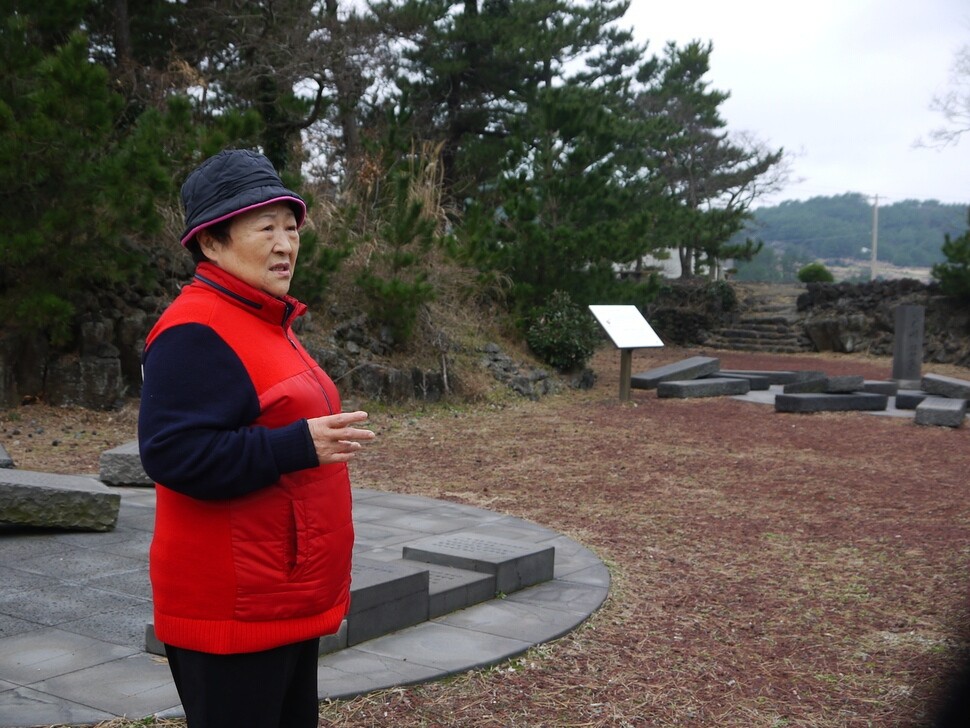
The girl who survived an execution
“The dirt at Omtang [Ompang] Field in Bukchon Village was dark-red, and had turned black with blood. It was past four in the afternoon, and whenever a ray of sunshine shown through the clouds, the blood would gleam like a glass bead, the way the light reflects off the ice. My face was drenched in tears, and it was cold, though that thought did not occur to me.”
This was how Koh Wan-sun, 78, head of the elderly association at Bukchon Village, described what had happened at the execution ground at Neobeunsungi Ompang Field on Jan. 17, 1949, when she was nine years old. Behind her back, she could hear the clatter of rifles. Koh’s mother was carrying her little brother, who was 3 years old, on her back. With one hand, she gripped the hand of her older sister, who was 16 years old, and with the other, her own. Koh’s family had been taken to Ompang Field to be executed, but they were dramatically spared at the last moment. The bodies of villagers who had been executed shortly before lay around them in the field.
Just then a jeep full of soldiers pulled up, and the villagers heard shouted orders for the shooting to stop. These orders saved the lives of Koh and her family.
Prior to this, Koh and her family had stood on the threshold of death in the sports field at Bukchon Elementary School. While being pushed along, Koh had touched a woman who was already dead and gotten blood on her hand. When Koh moaned and said she was afraid, her brother on his mother’s back started whimpering about wanting to go home. His brother’s cries were silenced by a soldier who brought a truncheon down on his head twice. The boy never really recovered and died in 1952.
“As the women of Bukchon Village dived down to collect sea products and then went to the millet field to lay out the seaweed, their legs grew crooked. Even so, it was women who enabled our village to survive,” said Koh.
In Nov. 2012, Koh met Moon Jae-in, who was then running for president, at Neobeunsungi April 3 Memorial Hall in Bukchon Village. “Seventy years have gone by without my village of Bukchon receiving any consolation for the pain of the April 3 Uprising. Sometimes I think you will bring relief to that pain, which gives me something to look forward to,” Koh said in a handwritten letter she sent to Moon at the end of last year. Will her dream come true?
On Mar. 3, I visited Neobeunsungi, Bukchon Village, on Course 19 of the Olle Trail. Kim Byeong-seop, 41, and Park Jong-heon, 50, teachers at Gwangju Jeil High School, in the city of Gwangju, were talking with Lee Sang-eon, 56, a resident of Bukchon Village, as they explored the Neobeunsungi historical site. They were touring the site to prepare for a school trip planned for Mar. 28-30.
Walking through a heartbreaking history
“We don’t know the details of the Jeju Uprising, but we decided to come here anyway because it’s often compared to the Gwangju Uprising and because it’s receiving fresh historical attention. I had no idea that the Olle Trail had this kind of history,” Park said.
“We intend to treat this as an opportunity to tell the students about the Jeju Uprising,” Kim said.
Bukchon Village, Jocheon Township, Jeju City, is best known as the setting of “Uncle Suni,” a novella by Hyun Ki-young, who was born on Jeju Island. It was here on Jan. 17, 1949, that more than 200 villagers were slaughtered at Bukchon Elementary School and the surrounding fields by the third battalion of the second regiment, which was seeking revenge for the death of two soldiers in an ambush by armed militants. The next day, villagers who had fled to the nearby village of Hamdeok were executed on the grounds of being “the families of fugitives and guerillas.”
Over the course of these two days, more than 300 villagers were slaughtered, with no consideration taken of age or gender. Throughout the Jeju Uprising and Massacre, more than 600 people reportedly lost their lives at Bukchon Village. But even now, the perpetrators of the massacre are only identified as “the third battalion of the second regiment,” which no other details available.
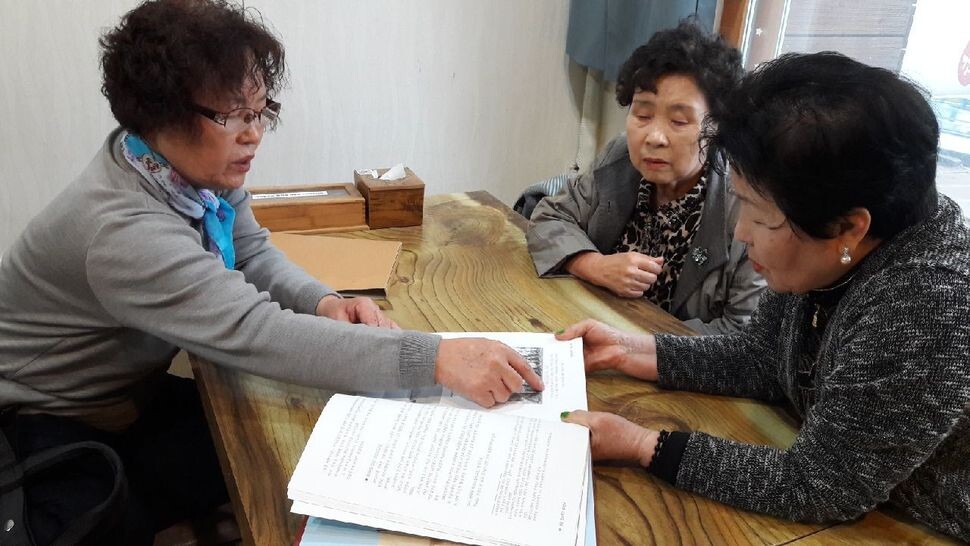
Three friends reunited after 58 years
“We were weeping and wailing. The things that happened during the Bukchon incident naturally came up in conversation. How could we forget what happened on the sports field at Bukchon Elementary School? I may have been young, but the memories of that time have stayed with me all my life…”
Brought together after 58 years apart, the friends’ conversation soon brought tears to their eyes. In April of last year, Kim Hyeon-ok (75, Donggwang Street, Jeju City) met some hometown friends – Lee Chun-ae (74, Seoul) and Kim Yong-hui (72, Seoul) – at a restaurant in the Eunpyeong District of Seoul. Hyeon-ok and Chun-ae had often seen each other, but not Yong-hui, who had become a “haenyeo” diver like her mother in her teens and then later settled in Gangwon Province. By chance the three had gotten in touch again and then met in Seoul, 58 years after parting ways in 1960. As they embraced each other, they wept.
On Jan. 17, 1949, the day of the massacre at Bukchon Village, the three girls had all been on the sports field at Bukchon Elementary School, with their mothers and fathers holding them by the hands. Hyeon-ok had been six years old, Chun-ae five, and Kim Yong-hui three – and Hyeon-ok lost her father (Kim Yu-shin, 50 at the time), Chun-ae her mother, and Yong-hui her father. Though the three girls had been born on different days, they all lost a parent on the same day, and they became close friends who depended upon each other.
Hyeon-ok’s mother (Lee Cha-bok) was left a widow, with one son and three daughters to support. The day after the massacre at Bukchon, Kim Geum-taek, 83, Hyeon-ok’s elder sister by eight years, carried her to their aunt’s house in Hamdeok along with their mother. A few days later, their mother went home and buried their father in the field, covering his body with a straw sack without holding any kind of funeral. Just like the other Bukchon villagers, the life of the Kim family was full of hardship from that point forward.
The Kim family stayed in Hamdeok until the spring, when they returned to Bukchon. But the village had been burned to ground and there was nothing left but charred ruins.
“Before the Bukchon incident, my parents weren’t sure what would happen, so they put a little money in a small pot and buried it in the vegetable garden,” Hyeon-ok recalled. Their mother dug up the pot from the garden next to the ashes of their house and recovered the money that would keep the Kim family alive after the Jeju Uprising. With that money, the family bought hairbrushes that they sold in villages in the foothills around Mount Halla.
“We stacked up a wall of stones around the ruins of the house and covered the top to make a shack. Three families lived together—five people in my family, three in another and five in a third. There were 13 people living in that single hut,” Hyeon-ok recalled. They had no plates, so they ate out of abalone shells. There was little to eat, so they had to make do with barley rice mixed with various kinds of seaweed.
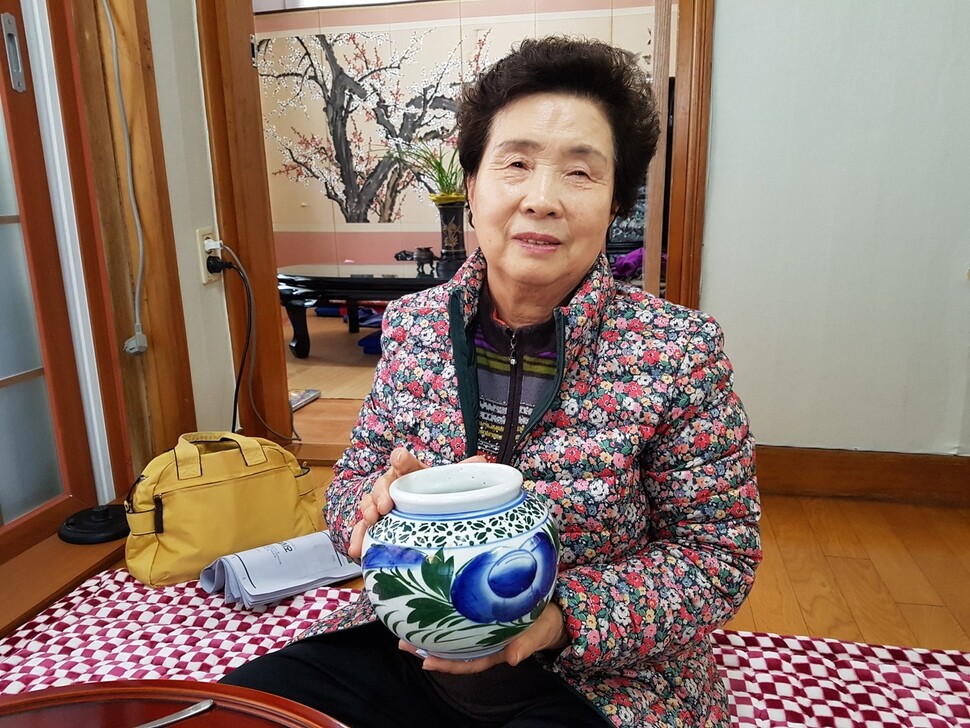
About two months after the family had moved from Hamdeok to Bukchon, a sibling who was three years younger than Hyeon-ok died of malnutrition. Another blow came when her older brother Kim Cheol, now 79, came down with the measles and lost his eyesight. This was a time when the country was ravaged by infectious disease and numerous people starved to death. In June of that year, Hyeon-ok’s younger brother Hui-jun, 69, was born. Her mother had been pregnant at the time of the massacre. But just 23 days after giving birth, her mother went back to work with the infant on her back, buying firewood and borrowing someone’s cart to take it downtown to resell.
“How could I tell all the stories from that time? And it’s not just me. My husband, who passed away a few years ago, saw his mother shot down with his own eyes. Just imagine how he must have felt! If I was a writer, the novel I would write would go on for several volumes,” Hyeon-ok said.
“Our lives have all been the same. We may not tell each other about it, but we know,” she said, as tears welled up in her eyes.
By Heo Ho-joon, Jeju correspondent
Please direct questions or comments to [english@hani.co.kr]

Editorial・opinion
![[Column] Has Korea, too, crossed the Rubicon on China? [Column] Has Korea, too, crossed the Rubicon on China?](https://flexible.img.hani.co.kr/flexible/normal/500/300/imgdb/original/2024/0419/9317135153409185.jpg) [Column] Has Korea, too, crossed the Rubicon on China?
[Column] Has Korea, too, crossed the Rubicon on China?![[Correspondent’s column] In Japan’s alliance with US, echoes of its past alliances with UK [Correspondent’s column] In Japan’s alliance with US, echoes of its past alliances with UK](https://flexible.img.hani.co.kr/flexible/normal/500/300/imgdb/original/2024/0419/2317135166563519.jpg) [Correspondent’s column] In Japan’s alliance with US, echoes of its past alliances with UK
[Correspondent’s column] In Japan’s alliance with US, echoes of its past alliances with UK- [Editorial] Does Yoon think the Korean public is wrong?
- [Editorial] As it bolsters its alliance with US, Japan must be accountable for past
- [Guest essay] Amending the Constitution is Yoon’s key to leaving office in public’s good graces
- [Editorial] 10 years on, lessons of Sewol tragedy must never be forgotten
- [Column] A death blow to Korea’s prosecutor politics
- [Correspondent’s column] The US and the end of Japanese pacifism
- [Guest essay] How Korea turned its trainee doctors into monsters
- [Guest essay] As someone who helped forge Seoul-Moscow ties, their status today troubles me
Most viewed articles
- 1[Column] The clock is ticking for Korea’s first lady
- 2After 2 months of delayed, denied medical care, Koreans worry worst may be yet to come
- 3Hong Se-hwa, voice for tolerance whose memoir of exile touched a chord, dies at 76
- 4[Column] Has Korea, too, crossed the Rubicon on China?
- 5US overtakes China as Korea’s top export market, prompting trade sanction jitters
- 6Samsung barricades office as unionized workers strike for better conditions
- 7[Editorial] As it bolsters its alliance with US, Japan must be accountable for past
- 8[Correspondent’s column] In Japan’s alliance with US, echoes of its past alliances with UK
- 9All eyes on Xiaomi after it pulls off EV that Apple couldn’t
- 10[Correspondent’s column] The US and the end of Japanese pacifism